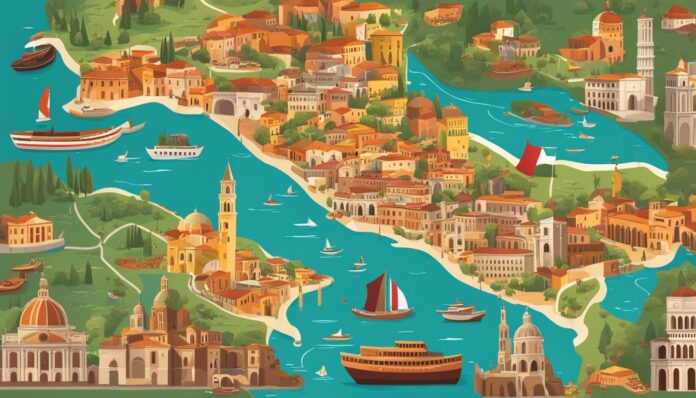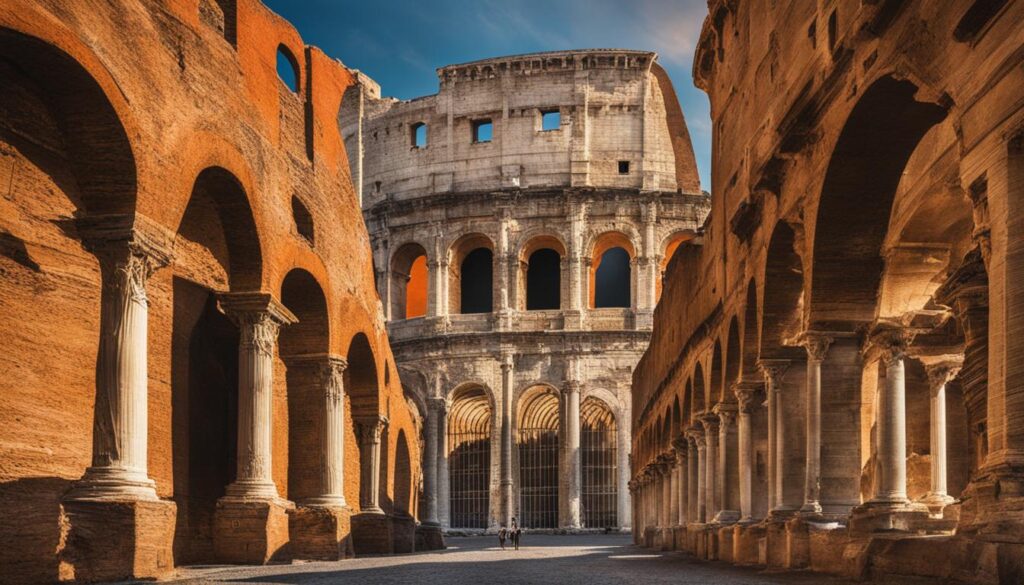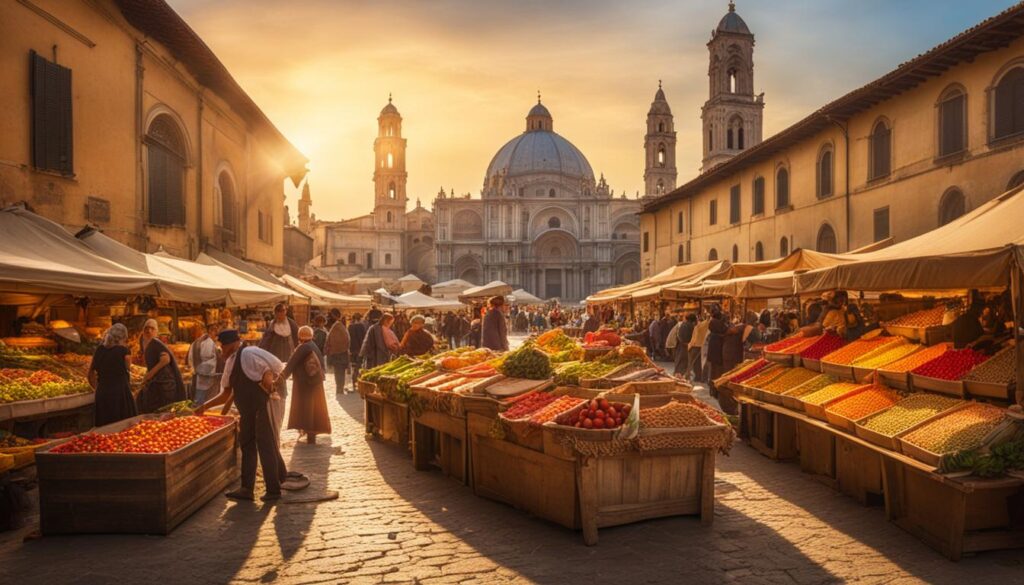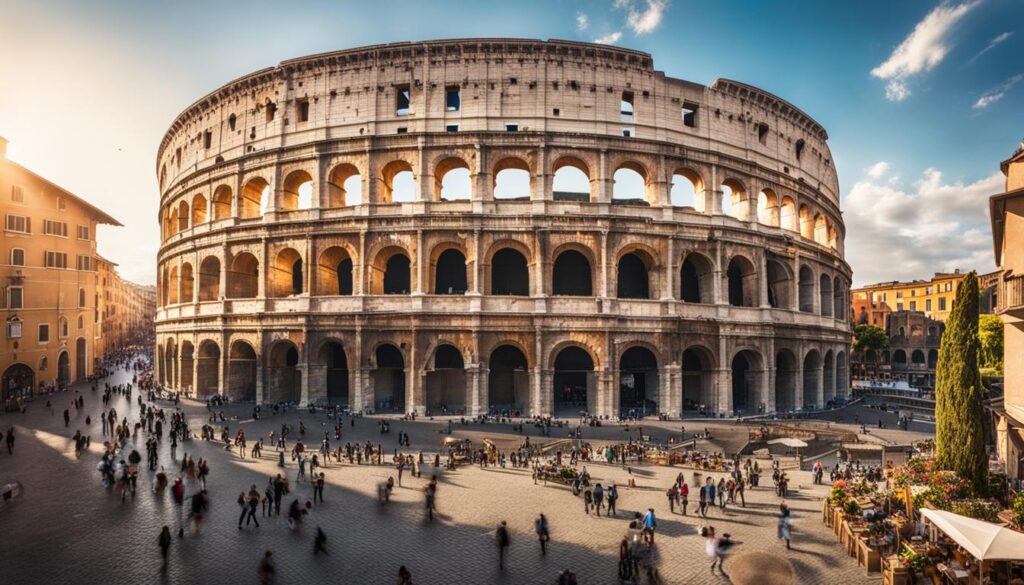Welcome to your beginner’s guide to Italian history and culture! Italy is a country steeped in rich history, art, music, and food. Perhaps you have booked a trip to Italy and want to get to know the customs, traditions, and the country’s rich heritage. Alternatively, you may be interested in learning about the Italian way of living. Whatever your motivation, this guide is going to provide you with an introduction to Italy’s captivating history and culture that will help you understand its people, customs, and past.
Over the course of this guide, you will explore Italy’s historical and cultural background, starting from its ancient civilization to modern times. You’ll learn about the various cultural aspects of Italian life, including language, cuisine, festivals, and celebrations. We hope that by the end of this guide, you’ll have a solid understanding of the Italian way of life and the country’s heritage.
So, are you ready to embark on a journey to Italy without leaving your home? Let’s discover the beauty, charm, and fascinating history of Italy together!
The Origins of Italy
Italy is a country with a rich and fascinating history that dates back to ancient civilizations. The origins of Italy can be traced back to the Etruscans, who lived in central Italy between the 8th and 3rd centuries BCE. They were known for their metalworking skills, art, and sophisticated society.
Another important civilization in Italian history is the Romans, who emerged in the 6th century BCE and eventually conquered much of Europe and the Mediterranean. The Roman Empire had a far-reaching impact on the culture and societies of its conquered territories, including Italy.
Other key civilizations that shaped the early history of Italy include the Greeks, who founded colonies in southern Italy, and the Lombards, who established a kingdom in northern Italy in the 6th century CE.
The Etruscans
| Key Facts | Etruscan Society and Culture |
|---|---|
| The Etruscans lived in central Italy between the 8th and 3rd centuries BCE. | The Etruscans were known for their art, metalworking, and advanced society. They had their own system of writing, religion, and government. |
| The Etruscans developed a complex trade network and had strong ties with the Greeks and Carthaginians. They traded in metals, luxury goods, and other commodities. | Etruscan society was divided into different classes, with aristocratic families holding most of the power. Women enjoyed a higher status in Etruscan society than in most other ancient civilizations. |
| The Etruscans believed in the afterlife and practiced divination and other forms of religious ritual. Their art and architecture often incorporated religious themes. |
The Romans
| Key Facts | The Roman Empire |
|---|---|
| The Romans emerged in the 6th century BCE and eventually conquered much of Europe and the Mediterranean. They established a vast empire that lasted for centuries. | The Roman Empire had a profound impact on the culture, politics, and societies of its conquered territories. Roman architecture, engineering, and art continue to influence modern Western culture. |
| The Romans developed a sophisticated system of government, law, and infrastructure, including roads, aqueducts, and public buildings. | The Roman Empire ultimately declined due to internal decay and pressure from outside forces, such as barbarian invasions. However, its legacy lives on in the form of modern Western culture. |
The Etruscans and the Romans are just two examples of the many civilizations that have contributed to the rich tapestry of Italian history and culture. By exploring Italy’s past, we can gain a greater appreciation for its present and future.
The Roman Empire
Get ready to travel back in time and explore one of the most powerful and influential empires in human history: the Roman Empire. Italians take great pride in their connection to this legendary civilization, which spanned three continents and lasted for over five centuries. If you’re interested in Italian history and culture, it’s crucial to have a solid understanding of the achievements, principles, and destinies of the Roman Empire.
The Roman Empire had a profound impact on world history and Western civilization. From the extensive road network that facilitated trade and the spread of ideas, to the impressive artistic and architectural achievements, the Roman Empire left a lasting mark on the world. Its social, political, and military innovations continue to influence modern politics, law, and warfare.
The decline and fall of the Roman Empire was a complex process that has been the subject of intense scrutiny by historians and scholars. Many factors contributed to its eventual collapse, including internal corruption and decay, external invasions and conflicts, political infighting, and economic instability.
Notable achievements of the Roman Empire:
| Field | Examples |
|---|---|
| Art and architecture | Colosseum, Pantheon, Aqueducts |
| Law and politics | Civil law, senate, citizenship |
| Military | Legions, tactics, conquests |
| Science and engineering | Astronomy, medicine, roads |
Source: history.com
As you can see from the table above, the Roman Empire achieved remarkable success in several fields, leaving behind a legacy that still resonates today. Studying its history and culture is an essential step towards understanding the deep-rooted and complex nature of Italy’s most significant contributions to world civilization.
Medieval Italy
Medieval Italy was a time of great change, marked by feudalism, city-states, and the rise of powerful families like the Medici. During this era, art and architecture flourished, and Italy became a center of culture and innovation.
One of the most significant developments of this period was the rise of the city-state. Italian city-states were powerful, independent entities that emerged as a result of the collapse of medieval feudalism. Some of the most famous city-states included Venice, Florence, and Genoa.
The city-states were ruled by powerful families like the Medici, who gained immense wealth and influence through trade and banking. They patronized the arts and sciences, leading to a flourishing of creativity. The art and architecture of this era are some of the most stunning and enduring in the world, such as the Gothic architecture of Milan Cathedral or the frescoes of Giotto in Florence.
The Arts and Literature
Medieval Italy was a time of artistic and literary innovation. Literature like Dante’s Divine Comedy and Petrarch’s sonnets were groundbreaking works that influenced Italian culture for centuries to come. Art also flourished, with the development of the Gothic style and the birth of the Renaissance.
The Church
The Church played a significant role in Italian medieval society, with the pope exercising immense power over both religious and temporal matters. The papacy was centered in Rome, and many beautiful churches and cathedrals were built during this time.
The Table
| Food | Description |
|---|---|
| Risotto | A dish made with Arborio rice and various additions, including vegetables, meat, or seafood. |
| Polenta | A dish made from boiled cornmeal, often served with meat or cheese. |
| Tiramisu | A dessert made with layers of coffee-soaked ladyfingers, mascarpone cheese, and chocolate. |
| Prosciutto | A type of cured ham, often served thinly sliced with cheese and bread. |
In terms of cuisine, medieval Italy was known for its simple but delicious dishes, often made with local ingredients. Risotto, polenta, and different kinds of pasta originated during this period. Desserts such as tiramisu also have their roots in medieval Italy.
The Legacy of Medieval Italy
Medieval Italy was a time of great change and innovation, with powerful city-states, beautiful art and architecture, and a thriving literary scene. Many of the cultural traditions that we associate with Italy today have their roots in this fascinating era.
The Renaissance in Italy
The Renaissance was a period of great innovation and creativity in Italy. This cultural and intellectual movement began in the 14th century and lasted until the 17th century. Many of the greatest works of art and literature in Italian history were produced during this time.
During the Renaissance, Italian society placed a strong emphasis on humanism, the idea that humans are capable of great achievements and have the potential to be great. This mindset paved the way for great advances in art, science, and literature. Some of the most famous artists of all time, like Leonardo da Vinci and Michelangelo, lived during this era and produced some of their most iconic works.
The Renaissance was also a time of great scientific discovery. Individuals like Galileo Galilei and Nicolaus Copernicus made important contributions to the fields of astronomy and physics.
The impact of the Renaissance on Italian society cannot be overstated. It was a time of great change and innovation that continues to influence art and culture around the world today.
Italian Unification
Italian unification is a significant period in Italian history that led to the formation of the modern nation-state of Italy. The process began in the mid-19th century and involved the consolidation of numerous smaller states into one united kingdom.
Some of the essential aspects of Italian unification include the leadership of Giuseppe Garibaldi, the involvement of different European powers in the process, and the challenges faced by the movement, such as resistance from the Catholic Church and conservative factions.
To help you understand this critical era, take a look at the following table, which highlights the key events and figures of the Italian unification movement:
Key Figures and Events of Italian Unification
| Year | Event | Key Figure |
|---|---|---|
| 1815 | Congress of Vienna | Metternich |
| 1831 | Revolution in Modena and Parma | |
| 1846 | Revolution in Naples | Garibaldi |
| 1848 | Revolution in Sicily | Mazzini |
| 1859 | Second War of Independence | Cavour |
| 1861 | Proclamation of the Kingdom of Italy | Victor Emmanuel II |
Italian unification was a complex process that significantly impacted the course of Italian history, politics, and culture. By understanding the events, figures, and challenges of this era, you can gain a better appreciation for the rich heritage of Italy.
Modern Italy
Italy experienced rapid changes throughout the 20th century, undergoing a transformation from a rural society to an industrialized country. World War II caused significant destruction, especially in the north. Post-war Italy saw enormous economic growth, fueled by a manufacturing sector and a construction boom, leading to the so-called Economic Miracle of the 1950s.
While the economic boom brought prosperity and modernization to many parts of the country, some regions, especially in the south, still faced poverty and underdevelopment. Today, modern Italy is a member of the G7 and the European Union, facing contemporary challenges such as immigration, political instability, and economic inequality.
Contemporary Italy: A Quick Look
| Aspect | Details |
|---|---|
| Population | 60 million people, with a low birth rate and a high life expectancy. |
| Politics | Italy is a parliamentary republic, with a President as head of state and a Prime Minister as head of government. The country has a multi-party system, with political instability and corruption being persistent problems. |
| Economy | A mixed economy, with a focus on services and manufacturing. Italy is the world’s eighth-largest economy, but faces challenges such as high public debt, unemployment, and a north-south divide. |
| Culture | Italian culture is renowned for its food, wine, fashion, design, and art. Italian cuisine is varied and regional, with an emphasis on simple, fresh ingredients. Fashion and design are major industries, with world-famous brands such as Gucci, Armani, and Prada. |
Despite its challenges and complexities, Italy remains a fascinating country with a rich history and culture. Understanding its journey through the 20th century is essential to understanding the modern Italy we see today.
Italian Language and Literature
Learning the Italian language and exploring its rich literary tradition is a wonderful way to immerse yourself in the country’s culture. The Italian language is the official language of Italy and is also widely spoken in other parts of Europe, making it a popular language to learn worldwide.
The history of Italian literature is rich and diverse, with many works that have had a significant impact on the literary world. Famous Italian authors, such as Dante Alighieri, Giovanni Boccaccio, and Petrarch, have contributed greatly to Italian literature.
If you want to learn Italian, there are many resources available, including language schools, online courses, and study abroad programs. Some essential aspects of Italian history and culture that you can explore through literature are:
- The Renaissance period: Italian Renaissance literature was characterized by a focus on humanism and individualism, leading to the creation of some of the greatest masterpieces in Italian literature.
- The Divine Comedy: Written by Dante Alighieri, a masterpiece of Italian literature that has had a significant impact on the field of literature worldwide.
- The Leopard: A novel by Giuseppe Tomasi di Lampedusa, which is an essential read that showcases the history of Italy.
If you’re planning a trip to Italy, learning some basic Italian phrases and understanding the culture will enhance your experience. Remembering a few key phrases such as “Ciao” (hello/goodbye), “Per favore” (please), and “Grazie” (thank you) can go a long way in showing respect for Italian culture.
Italian Art and Architecture
Italy has a rich artistic and architectural heritage that spans centuries and continues to inspire people around the world today. From the frescoes of the Sistine Chapel to the towering Colosseum, Italian art and architecture are essential aspects of Italian history and culture that deserve to be explored and celebrated.
If you’re interested in learning more about Italian art and architecture, the first step is to understand the different historical eras and artistic styles that have shaped this country’s cultural landscape. For example:
- The Renaissance period, which saw the rise of artists like Leonardo da Vinci and Michelangelo, as well as the emergence of new techniques like perspective and sfumato.
- The Baroque period, which was characterized by elaborate ornamentation, dramatic lighting, and dynamic movement.
- The Neoclassic period, which looked to ancient Greek and Roman art for inspiration and emphasized a return to classical ideals.
Alongside these art styles are architectural styles that have left their mark on Italy. For example:
- The Romanesque style, which is characterized by simple, sturdy structures with rounded arches and barrel vaults.
- The Gothic style, which features intricate details and pointed arches, as seen in the famous Milan Cathedral.
- The Renaissance style, which reflects the aesthetic ideals of the time, with symmetrical, harmonious proportions and a focus on balance and symmetry.
Italian art and architecture have left their mark on the world in countless ways, influencing other cultures and inspiring artists and architects for generations. Whether you’re standing in front of a masterpiece in a museum or admiring the façade of a centuries-old building, the beauty and history of Italian artistic and architectural traditions are sure to captivate.
Italian Cuisine and Traditions
Italian cuisine is one of the most beloved and celebrated in the world, and it reflects the country’s rich history and regional diversity. From fresh pasta and aromatic sauces to succulent meats and artisanal cheeses, Italian food is a feast for the senses.
True to its cultural roots, Italian dining is a communal and social experience that emphasizes conversation, relaxation, and the enjoyment of good food and wine. Whether you’re dining in a cozy trattoria or a Michelin-starred restaurant, the emphasis is on taking time to savor each bite and share the experience with those around you.
Regional Specialties
Italian cuisine varies greatly across regions, with each area featuring its own unique flavors and ingredients. In the North, risotto and polenta are popular staples, while the central regions are known for dishes like pasta all’amatriciana and porchetta. In the South, seafood reigns supreme, with dishes like spaghetti alle vongole and fried calamari gracing the tables.
Dining Etiquette
Italian dining comes with its own set of rules and customs. When entering a restaurant, wait to be seated rather than choosing a table yourself. Keep in mind that the bread on your table is not meant to be eaten with oil and vinegar, but rather to mop up sauce or add to your meal. Never cut your pasta noodles with a knife, as this is considered a vulgar gesture. And when eating pizza, always use a knife and fork rather than your hands.
Italian Gastronomic Heritage
“The trouble with eating Italian food is that five or six days later you’re hungry again.” – George Miller
With its long history and rich culinary traditions, it’s no surprise that Italian cuisine has been designated by UNESCO as part of the world’s Intangible Cultural Heritage. From the production of Parmigiano Reggiano cheese and Prosciutto di Parma ham to the art of Neapolitan pizza-making and the cultivation of Sangiovese grapes for Chianti wine, Italian gastronomy is a true cultural and gastronomic treasure.
Festivals and Celebrations in Italy
Experience the vibrant and colorful world of Italian festivals and celebrations. Participate in religious and cultural events that bring together communities throughout the country, showcasing Italy’s vibrant traditions and heritage.
If you happen to be in Florence during Easter, be sure to witness the explosive Scoppio del Carro, or “Explosion of the Cart,” a spectacle where a cart is filled with fireworks and set alight in front of the Cathedral.
Another spectacular event is the Palio di Siena, a horse race that takes place in the Piazza del Campo in Siena. Ten horses and riders dressed in brilliant livery race around the square, representing different city districts.
Feeling hungry? Visit Turin during the Salone del Gusto, a biennial food festival that celebrates Italian gastronomic culture. Sample delicious cheeses, cured meats, and fine wines from all over Italy.
Throughout the year, there are countless festivals and celebrations that showcase Italy’s rich cultural and religious traditions. From Carnevale in Venice to the Festa della Sensa in Venice, each event offers a unique and unforgettable experience.
Conclusion
Congratulations! You have completed your beginner’s handbook on Italian history and culture. We hope that you found this guide informative and engaging, and that it has sparked your interest in further exploring the fascinating world of Italy. Remember, this is just the beginning of your journey. There is so much more to discover when it comes to Italian history, art, language, cuisine, and traditions. We encourage you to continue your learning and exploration, whether through travel, books, or online resources. Buona fortuna!
















































